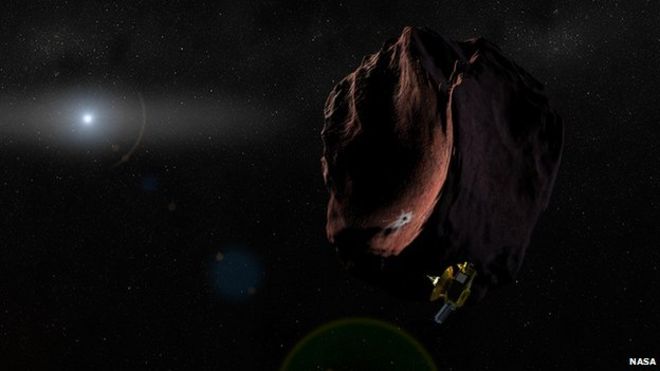New Horizons: Pluto probe's next target chosen

Nasa's New Horizons spacecraft has a new target to aim for following its historic flyby of Pluto.
It is called 2014 MU69, and was one of two comet-like objects that were under consideration by scientists working on the mission.
The US space agency will now carry out a review of the plan before officially approving the mission's extension.
New Horizons carried out its flyby of Pluto in July, approaching to 12,500km from the dwarf planet's surface.
The spacecraft captured detailed images and other data not only of Pluto, but also of its moons: Charon, Styx, Nix, Kerberos and Hydra.
The new target is about a billion and a half km beyond Pluto. It is about 45km across and is thought to be one of the building blocks from which bigger worlds such as Pluto are formed.
Such objects form a region of the outer Solar System called the Kuiper Belt, containing a deep-freeze sample of what our cosmic neighbourhood was like when it formed 4.6 billion years ago.
'Exciting science'
"Even as the New Horizon's spacecraft speeds away from Pluto out into the Kuiper Belt, and the data from the exciting encounter with this new world is being streamed back to Earth, we are looking outward to the next destination for this intrepid explorer," said John Grunsfeld, head of Nasa's Science Mission Directorate.
"We expect it to be much less expensive than the prime mission, while still providing new and exciting science."
The spacecraft carries enough hydrazine fuel for another flyby, and scientists say it could continue operating into the late 2020s or beyond.
The mission's principal investigator, Alan Stern, called Nasa's selection of 2014 MU69 "a great choice".
He added: "This KBO costs less fuel to reach [than other candidate targets], leaving more fuel for the flyby, for ancillary science, and greater fuel reserves to protect against the unforeseen."
In summer 2014, the Hubble Space Telescope was used to discover five icy objects, later narrowed to two, within New Horizons' flight path.
In late October and early November, the spacecraft will perform a series of engine burns to set its course toward 2014 MU69 ahead of an encounter currently set for 1 January 2019.
| 




